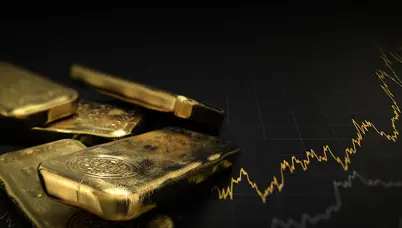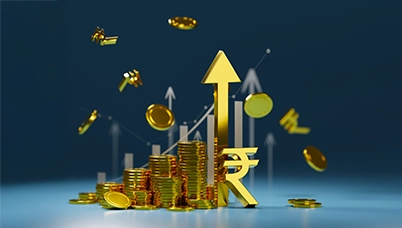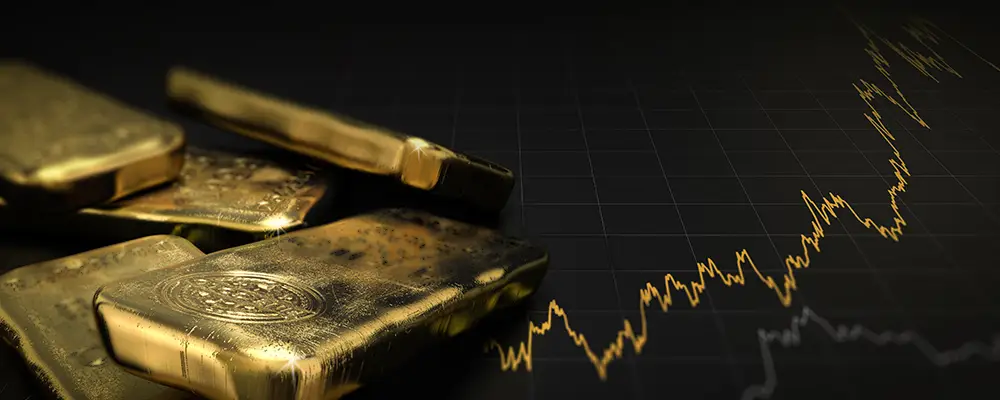Gold Monthly View for March 2025
Posted On Tuesday, Apr 08, 2025
After experiencing a surge of approximately 9% in 2025 through the end of February, gold prices further increased by an additional 9% in March, bringing year-to-date returns to around 19%. The much-anticipated $3,000 mark was finally surpassed, with gold reaching a record high of $3,123 supported by weaker dollar, recessionary fears, tariff uncertainty which led to weakness in equities. The ambiguity surrounding the potential implications of these tariffs and their effects on economies has fostered a sense of panic among investors. Consequently, gold has emerged as a beneficiary of this turmoil, experiencing increased demand as investors seek to diversify their portfolios away from risk assets.
Ever since the return of President Trump to the White House, the United States (U.S.) has consistently positioned itself as a mediator in the ongoing conflict between Russia and Ukraine, engaging in numerous diplomatic discussions among the involved parties. Despite these extensive efforts, a mutually agreeable resolution to the conflict is yet to be reached, leaving the situation shrouded in uncertainty. This uncertainty however has been proved to be favourable for Gold as the prices are rising given the possible economic risk emanating from the conflict.
We have been talking about the possibility of a recession in the U.S. with some of the indicators incrementally turning weak amidst uncertain policy making impacting the sentiments further. In line with that, recent discussions regarding a potential recession in the U.S. have intensified, with many experts expressing concerns about the economic outlook. When asked about the possibility of a recession, the President did not dismiss the notion, leading to a wave of anxiety in the U.S. equity markets. In contrast, the Federal Reserve appears to be standing by its earlier remarks made by Chairman Jerome Powell, asserting that "it's pretty clear we have avoided recession." The Fed remains committed to its strategy of implementing two rate cuts and chose not to lower interest rates during the meeting held on March 18, 2025. Current economic data presents a mixed picture, resulting in divided opinions among investors. The Federal Reserve has revised its growth forecast downward while increasing its inflation outlook, now projecting U.S. economic growth at 1.7% this year with inflation rising to 2.7%, up from previous estimates of 2.1% and 2.5%, respectively. The inflation for the month of February 2025 was reported to be 2.8%. Additionally, the Bureau of Labor Statistics reported the addition of 203,000 new jobs in February 2025, with the unemployment rate currently at 4.1%. This report has provided some reassurance to consumers and businesses concerned about the potential impact of tariffs related uncertainty.
Since the beginning of March 2025, the U.S. dollar (USD) has been under pressure, with the dollar index (DXY) falling by over 3%. Concurrently, the Indian Rupee (INR) has strengthened against the U.S. dollar, decreasing the USD/INR exchange rate from approximately 87.5 at the end of February 2025 to 85.4, an appreciation of over 2%. This strengthening of the rupee has helped mitigate rising gold prices for investors in India.
Outlook
With the breach of the $3,000 level, the current gold rally appears robust. However, the future trajectory of gold prices will largely depend on the unfolding economic trends impacted by new policies in April 2025. Tariff policies and geopolitical developments are likely to exert significant influence on gold prices in the short term. Increased tariffs can lead to market volatility and inflation concerns, prompting investors to seek gold as an investment, which may drive gold prices higher. Additionally, geopolitical tensions can further elevate demand for gold, reinforcing its status as a diversifier during uncertain times.
On April 02, 2025, President Trump announced reciprocal tariffs targeting several nations. While this move was largely anticipated, the precise impact on the U.S. economy remains uncertain. The central objective, as stated by Trump, is to strengthen the U.S. economy and "make America great again." However, the increased tariffs are expected to have significant repercussions on U.S. consumers as well. The higher import prices resulting from these tariffs could lead to rising costs, which in turn may reduce the purchasing power of the U.S. dollar. This scenario could potentially contribute to an overall economic slowdown and a notable increase in inflation, pushing the U.S. economy towards stagflation. In such an environment, gold is likely to benefit, as investors would seek refuge in the precious metal as a store of value. On the other hand, in a scenario of deteriorating growth and hardening inflation, if the Federal Reserve choses to support growth like it has sought to in the past overlooking inflation impact, it could be further supportive of gold as real rates would tend to decline.
However, with the oddly determined discounted reciprocal tariffs, the U.S. President appears to have adopted a stance that leaves room for further discussions and negotiations on this matter. Should additional developments or discussions occur regarding the imposition of tariffs reducing the impact, it could likely result in “peak uncertainty” for the time being, potentially causing a way for the world to move forward. However, such a scenario looks less probable at this juncture. Any unwinding of uncertainty or geopolitics could lead to unwinding such premium from current gold prices. On the other hand, any increase in uncertainty due to retaliatory reactions can further complicate matters, drive risk assets lower and gold would probably be bid higher.
Another major support for gold markets has been the central bank buying. Central banks bought more than 1,000 tons of gold for 3 years in a row to diversify away from predominant U.S. treasury holdings given uncertain policy making in the U.S.. With the recently announced tariffs, world would be inclined to look away from the U.S. and may even lead to investment flows moving away from the dollar, further weakening the dollar. We maintain our view that this long-term trend of diversification of reserves and investments will continue to unfold and probably accelerate marking an important support for gold markets.
In the long term, the policies implemented by central banks are likely to have a profound impact on the gold market. Should central banks continue to adopt accommodative monetary policies in response to ongoing economic challenges exacerbated by policymaking, this could provide additional support for gold prices. The escalation of trade tensions is expected to influence macroeconomic indicators and the overall growth trajectories of various countries. Considering these developments, central banks may opt to ease their monetary policies further and may also chart a course for potentially moving away from their reliance on a dominant currency holding. Such a shift could create a more favourable environment for gold, as the precious metal is traditionally viewed as a diversifier in times of competitive currency devaluations and economic instability. Consequently, the interplay between central bank actions and global economic conditions will be crucial in determining the future trajectory of gold prices, and something investors would keep an eye on.
Source: World Gold Council
 |
Disclaimer, Statutory Details & Risk Factors:The views expressed here in this article / video are for general information and reading purpose only and do not constitute any guidelines and recommendations on any course of action to be followed by the reader. Quantum AMC / Quantum Mutual Fund is not guaranteeing / offering / communicating any indicative yield on investments made in the scheme(s). The views are not meant to serve as a professional guide / investment advice / intended to be an offer or solicitation for the purchase or sale of any financial product or instrument or mutual fund units for the reader. The article has been prepared on the basis of publicly available information, internally developed data and other sources believed to be reliable. Whilst no action has been solicited based upon the information provided herein, due care has been taken to ensure that the facts are accurate and views given are fair and reasonable as on date. Readers of this article should rely on information/data arising out of their own investigations and advised to seek independent professional advice and arrive at an informed decision before making any investments. Mutual Fund investments are subject to market risks, read all scheme related documents carefully. |
Related Posts
-

Gold Monthly View for March 2025
Posted On Tuesday, Apr 08, 2025
After experiencing a surge of approximately 9% in 2025 through the end of February, gold prices further increased by an additional 9% in March, bringing year-to-date returns to around 19%.
Read More -

Gold Monthly View for February 2025
Posted On Friday, Mar 07, 2025
The bullish momentum for gold carried on into February 2025, with spot prices maintaining
Read More -

Gold Monthly View for January 2025
Posted On Friday, Feb 07, 2025
In the calendar year 2024, gold demonstrated remarkable performance, yielding a return of ~ 27%.
Read More




